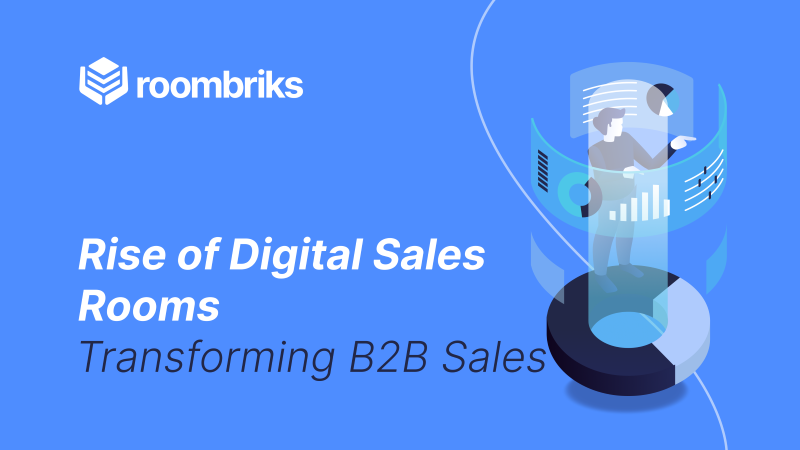The Rise of Digital Sales Rooms: Transforming B2B Sales

roombriks team
Creating a better way to engage in a b2b relationship.

Get Started With Your first Digital Sales Room
Summary
This article explores the transformative impact of digital sales rooms (DSRs) on the B2B sales landscape. In response to the digital revolution, traditional sales methods are giving way to dynamic, online interactions within virtual spaces in a virtual selling-first world. Digital Sales Rooms or Digital Collaboration Rooms go beyond static repositories, fostering collaboration and personalized journeys for sales teams and customers. This method offers the opportunity to gain better buying signals.
Beyond Email and Other Digital Correspondence
The landscape of B2B sales is undergoing a dramatic shift, driven by the digital transformation sweeping across industries. Traditional physical meetings and email chains are being replaced by a more dynamic and interactive experience: digital sales rooms (DSRs).
What are Digital Sales/Collaboration Rooms?
Imagine a virtual space where sales teams and potential customers can collaborate, share information, and engage in a personalized sales journey – all online. DSRs are more than just repositories for brochures and presentations. They’re interactive hubs that foster deeper connections and understanding between sellers and buyers.
Challenges with Email and Document Sharing
Limited Interactivity:
Lack of interactive elements in email attachments and shared documents hampers dynamic engagement with clients.
Version Control Issues:
Difficulty in managing and ensuring that all parties are working with the latest version of a document, leading to potential confusion.
Security Concerns:
Email attachments pose security risks, and once sent, control over who accesses the document can be limited, potentially resulting in unauthorized access or data breaches.
Inefficient Collaboration:
Collaboration through email may involve multiple rounds of feedback and revisions, leading to a time-consuming and disjointed process.
Unsecured Communication:
Communication through email may lack encryption and security measures, exposing sensitive information to potential risks.
Branding and Presentation Limitations:
Email attachments may not provide a polished and branded presentation experience, potentially impacting the overall impression on clients.
Limited Real-time Communication:
Lack of real-time communication features in email, hindering immediate interaction during presentations or discussions.
Access Control Challenges:
Challenges in controlling and restricting access to specific documents or information sent via email, potentially compromising confidentiality.
Ineffective Content Organization:
Searching through emails to find specific documents can be time-consuming and inefficient.
Mobile Accessibility Limitations:
The experience of viewing email attachments on mobile devices may not be optimal, potentially affecting accessibility.
Lack of Customization and Personalization:
Difficulty in adapting and customizing presentations dynamically during a meeting based on client preferences and needs.
Insufficient Tracking and Analytics:
Limited or no analytics capabilities in traditional email and document sharing, making it challenging to gather insights into client interactions.
Content Versatility:
Constraints in supporting diverse types of content beyond traditional documents, limiting the versatility of sales presentations.
Advantages of Digital Sales Rooms
Interactive and Personalized Content:
DSRs enable the creation and delivery of dynamic and interactive content, fostering a personalized experience for sales teams and customers.
Centralized and Controlled Access:
DSRs provide a centralized platform with controlled access, ensuring secure sharing of documents and restricting access based on permissions.
Real-time Updates:
Changes made to documents or presentations in DSRs are instantly reflected, ensuring everyone has access to the latest information in real-time.
Data Analytics and Insights:
DSRs often come equipped with analytics tools that track user engagement, providing valuable insights for sales teams to tailor their approach based on buyer behavior.
Efficient Workflow Automation:
DSRs streamline workflows by automating tasks such as proposal generation and document sharing, freeing up time for sales reps to focus on strategic activities.
Enhanced Collaboration:
DSRs facilitate seamless collaboration among team members and clients, offering features like live chat, comments, and real-time editing for efficient communication.
Branding and Presentation Excellence:
DSRs provide a consistent and professional environment for presenting materials, reinforcing brand identity and leaving a lasting impression on clients.
Real-time Communication:
Features like live chat or instant messaging in DSRs enable real-time communication during presentations, addressing queries promptly and fostering a more interactive sales process.
Access Control and Permissions:
You can offer granular control over access permissions, allowing sales teams to manage and restrict access to specific documents or sections, ensuring confidentiality.
Customization and Personalization:
Digital Rooms Allow for greater customization of content based on client preferences, adapting presentations dynamically during a meeting for a more personalized sales experience.
Mobile Accessibility:
These rooms are designed with mobile responsiveness in mind, ensuring that clients can access and engage with materials seamlessly on various devices.
Tracking and Analytics:
With roombriks sales rooms out of hte box provide advanced tracking and analytics tools, allowing sales teams to gain insights into how clients interact with specific content and tailor their follow-up strategies accordingly.
Comprehensive Engagement:
DSRs support various types of content beyond traditional documents, such as videos, interactive presentations, and multimedia, contributing to a more engaging and compelling sales pitch.
Why are DSRs gaining traction?
Several factors are fueling the rise of DSRs:
The remote-first world: The pandemic accelerated the shift to remote work, making physical meetings less feasible and highlighting the need for virtual collaboration tools.
Buyer expectations: Today’s informed buyers demand personalized experiences and access to relevant information readily available. DSRs cater to these expectations by providing customized content and interactive engagement.
Data-driven insights: DSRs track buyer behavior and content engagement, providing valuable data for sales reps to tailor their approach and improve win rates.
Enhanced efficiency: DSRs automate mundane tasks like proposal generation and document sharing, freeing up time for sales reps to focus on building relationships and closing deals.
Benefits of DSRs for businesses
Increased sales win rates: Personalized content, interactive engagement, and data-driven insights lead to more effective sales interactions and higher conversion rates.
Improved buyer experience: DSRs provide a seamless and engaging experience for buyers, fostering trust and loyalty.
Enhanced sales team productivity: Automation and streamlined workflows free up valuable time for sales reps to focus on strategic activities.
Data-driven decision making: DSRs provide valuable insights into buyer behavior, enabling data-driven sales strategies and improved ROI.
Closing Thoughts
While traditional email and document sharing have their merits, Digital Sales Rooms offer a more advanced and efficient solution for B2B sales. They enhance interactivity, security, and collaboration, ultimately improving the overall sales process and increasing the likelihood of successful deals.
